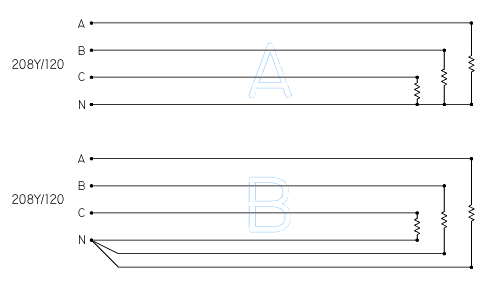mdmasterelectrician said:
I understand the principle and concept just not the calculations.
First, I would like to point out a consideration for determining the voltage drop of multiwire branch
subcircuits which can reasonably be expected to be on/off simultaneously.
Consider the situation depicted in the following image. Though labeled 208Y/120, the same situation applies to 480Y/277. When loads, distance from source, etc. on each A, B, and C lines are equal, the voltage drop in scenario "A" is half that of "B".
In short, if you keep the "imbalance" current on your netral conductor(s) at or near 0A, you only have to consider voltage drop on the line conductors and the current on the neutral conductor run between balancing loads. Otherwise, voltage drop will be increased due to current to the source on the neutral conductor and life expectancy of both fixtures and lamps will be decreased.
The service is set up mid way in the property and I will be feeding in multiple directions to accomplish this. I am trying to figure out the best scenario to get this done.
Right now I'm picturing a circle of 6,000 ft circumference with the power source located at the center. Please advise as to the correctness of this picture... and provide a vivid description!!! Is this perimeter illumination, such as along a fence line, or is it array lighting such as poles at grid intersections...
This is multiple circuited with every 3rd light pole on a circuit spread out along the run.
Please elaborate. Footage between poles, for example. Exactly how many poles... is it 89 poles with two luminaires each, or what? Provide fixture nameplate info and/or fixture manufacturer, model no., etc... Withholding info is only going to make it harder.
The voltage drop is very confusing to me, especially the reduction in conductor size the farther away you get.
We'll get to this if needed or desired... however it would be easier on all involved here to contribute on the actual rather than continue/start speculating on some phantom set up.

